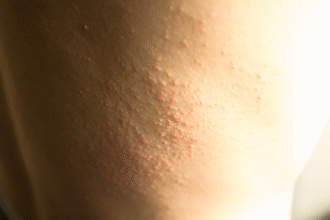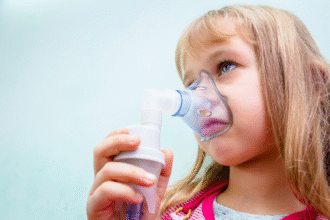Pertussis (Whooping Cough)
Pertussis is a highly contagious respiratory infection caused by Bordetella pertussis. It produces prolonged coughing fits that can lead to apnea, hypoxia, and complications—especially in infants who may lack the classic “whoop.” Early recognition and treatment reduce transmission.
Phases of Illness
- Catarrhal phase (≈1–2 weeks): mild upper‑respiratory symptoms (runny nose, mild fever, sneezing, intermittent dry cough) that progressively worsen; patient is most infectious.
- Paroxysmal phase (≈2–6 weeks or longer): bursts of rapid coughs (multiple forceful expirations) followed by a sudden, deep inspiratory effort producing the high‑pitched “whoop” (may be absent in infants). Post‑tussive vomiting and exhaustion are common. Cough is worse at night.
- Convalescent phase (weeks to months): cough gradually decreases in frequency and severity but may relapse with intercurrent viral infections.
Key Clinical Features
- Paroxysmal repetitive cough (10+ coughs per paroxysm), inspiratory whoop, and post‑tussive vomiting.
- Between paroxysms the child may appear relatively well.
- Infants: apnea, cyanosis, poor feeding instead of classic cough/whoop.
- Severe bouts may cause facial congestion, petechiae, subconjunctival hemorrhage, epistaxis, or (rarely) intracranial hemorrhage.
Complications
- Apnea, hypoxia.
- Secondary bacterial pneumonia (major cause of mortality in infants).
- Seizures, encephalopathy (hypoxic or rarely toxin‑mediated).
- Weight loss, dehydration, rib fractures (adolescents/adults).
Diagnosis
- Clinical suspicion: prolonged cough ≥2 weeks with paroxysms, whoop, or post‑tussive vomiting; any cough illness with apnea in infants.
- Lab findings: marked leukocytosis (often 30–50 × 10^9/L) with absolute lymphocytosis early.
- Microbiologic confirmation (ideally within first 2–3 weeks of cough):
- PCR on nasopharyngeal swab (preferred rapid method).
- Culture (specific, less sensitive later; important for surveillance/antimicrobial resistance tracking).
- Serology (useful later in illness; rising IgG to pertussis toxin) — retrospective in many settings.
- Collect specimens before or shortly after starting antibiotics for best yield.
Treatment
- Goals: limit transmission, mitigate symptoms (especially early), prevent complications in high‑risk patients.
- Antibiotics: most effective if started in catarrhal or early paroxysmal phase.
- First line: macrolides (azithromycin commonly preferred; erythromycin acceptable; clarithromycin in older children/adults). Typical azithromycin pediatric course: 5 days per local guidance.
- Alternative (macrolide intolerance): trimethoprim–sulfamethoxazole (age ≥2 months).
- Late antibiotic therapy may not change cough duration but still reduces spread.
- Supportive care: adequate hydration, small frequent feeds, manage vomiting, gentle suctioning of mucus (avoid vigorous stimulation that triggers cough). Monitor oxygen saturation in infants.
- Avoid routine cough suppressants; sedatives only under medical supervision for severe nocturnal spasms.
- Hospitalize infants <3 months or any child with apnea, cyanosis, dehydration, hypoxia, or complications.
Home Care Guidance
- Respiratory isolation: generally 5 days after starting effective antibiotics, or (if untreated) up to 3 weeks after paroxysmal cough onset.
- Calm environment; minimize triggers (smoke, strong odors, sudden temperature changes).
- Maintain nutrition: small, frequent, nutrient‑dense meals; continue breastfeeding.
- Sleep positioning to maintain airway patency; observe infants during/after paroxysms.
- Clear secretions gently; seek care if suctioning is difficult or breathing pauses occur.
- Monitor for signs of dehydration (reduced urine, dry mouth) and hypoxia (color change, pauses, lethargy).
Prevention
- Vaccination: adhere to routine DTaP schedule in infancy/childhood; Tdap booster for adolescents, pregnant people (each pregnancy, preferably 27–36 weeks) to protect newborns via passive antibodies.
- Post‑exposure prophylaxis: macrolide for close household contacts—especially if vulnerable (infants, pregnant, immunocompromised) per public‑health guidance.
- Early treatment of cases and proper respiratory etiquette (masking if coughing) reduce spread.
When to Seek Urgent Medical Care
- Apnea, cyanosis, breathing pauses.
- Persistent vomiting with inability to maintain hydration.
- Signs of respiratory distress (retractions, grunting, persistent hypoxia).
- Seizures, altered mental status.
- Infant <3 months with any paroxysmal cough.
Quick Reference Table (Summary)
- Phases: catarrhal (nonspecific) → paroxysmal (whoop, vomiting) → convalescent (gradual improvement).
- Key labs: leukocytosis with lymphocytosis early.
- Best early test: PCR on nasopharyngeal swab.
- First‑line therapy: macrolide (azithromycin); isolate for 5 days after start.
- High‑risk: young infants, unvaccinated, chronic lung/cardiac disease, immunodeficient.
Educational information only; suspected or severe pertussis requires professional medical evaluation and adherence to local public‑health guidance.






